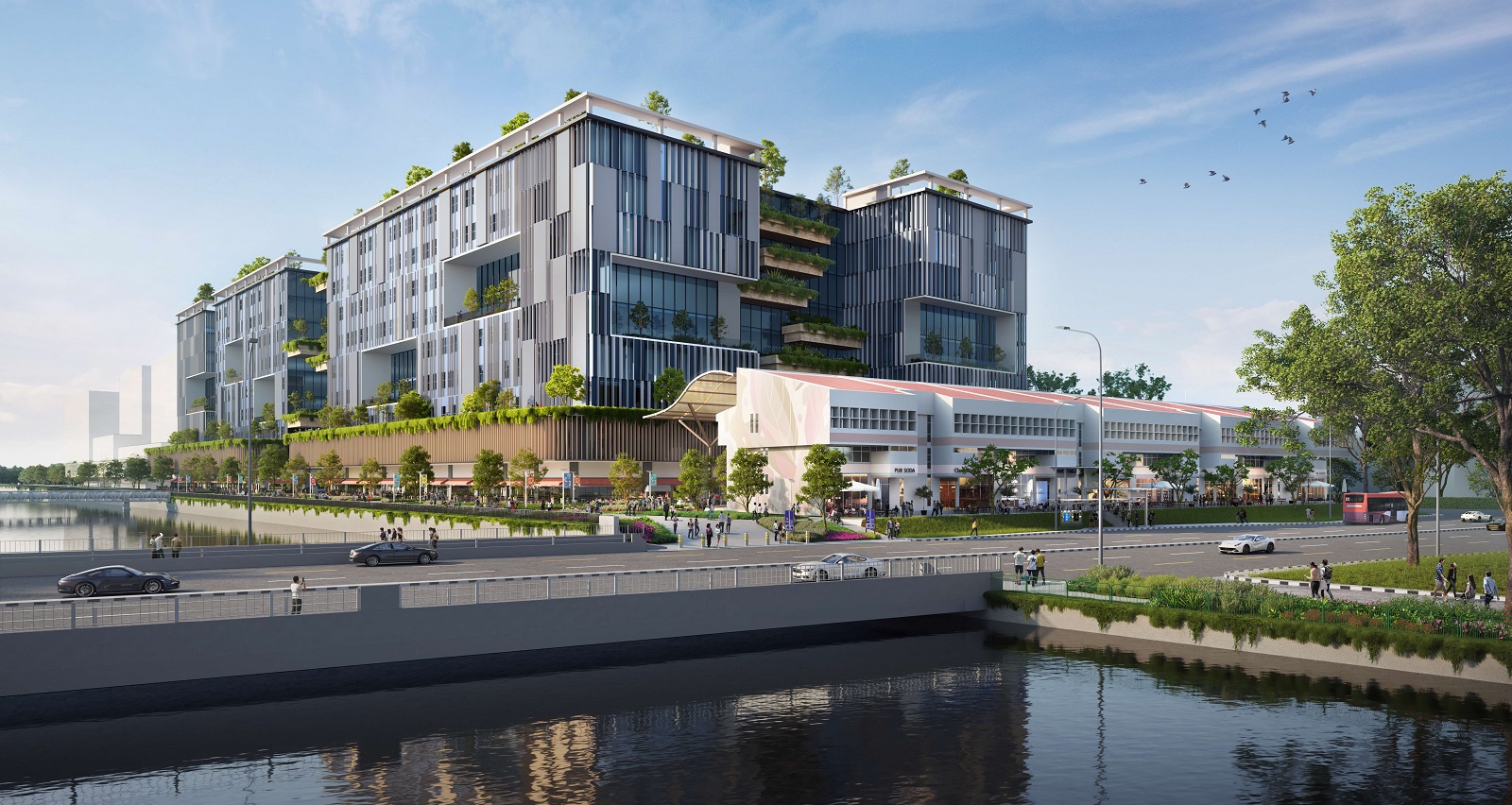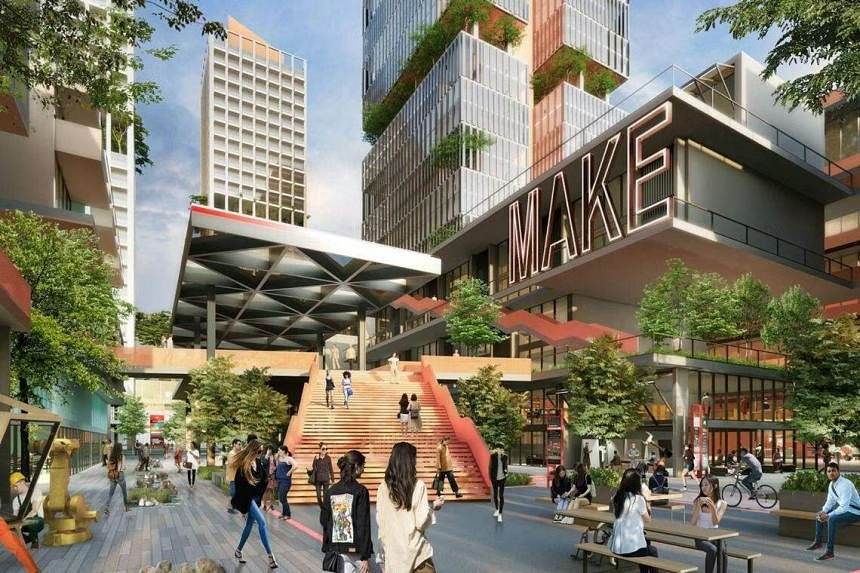As Singapore continues to evolve into a global manufacturing hub, the need for dynamic and innovative master planning and architecture design for industrial land becomes increasingly important.
“Singapore's unique challenge of land scarcity means we need to think of various strategies to optimise space,” observes Tang Hsiao Ling, director of JTC’s Urban Planning & Architecture Division. “The advent of Industry 4.0, characterised by automation and digitalisation, together with the continuous drive for knowledge-intensive industries has increased opportunities for more integration between industrial and non-industrial uses.”
JTC has been reviewing the land use plans of JTC estates to evolve brownfield sites and mature industrial estates into places where work, play or learn aspects can come together. For example, Sungei Kadut — one of the first industrial estates that helped to lay the foundation for Singapore’s manufacturing industry — is being rejuvenated to support the transformation of existing timber, metal, and waste management industries, and capture new opportunities in food-tech and agri-tech sectors.
In 2020, JTC launched a Request for Proposal (RFP) and invited local and international design professionals to submit blue sky ideas for the rejuvenation of two mature industrial estates: Yishun and Kallang-Kolam Ayer. The initiative saw architectural, planning, and design professionals propose bold visions that comprised cutting-edge approaches to urban planning and design, offering a glimpse into the exciting possibilities that meet the evolving needs of a more sustainable manufacturing landscape.
In line with its longer term industrial sustainable rejuvenation strategy, JTC is also piloting adaptive reuse as part of the requirements for an Industrial Government Land Sales (IGLS) site at Kallang Way. An existing terrace factory will be retained and adapted for continued manufacturing use, promoting sustainable redevelopment while preserving Singapore's industrial architectural legacy.
“The future of manufacturing is a lot cleaner, a lot sexier, and a lot quieter,” says Chintan Raveshia, the head of Cities Businesses, Arup Southeast Asia. One of several firms that participated in the RFP, Arup envisioned a revitalised Yishun industrial estate connected to its surrounding neighbourhoods via an extensive green and blue network.
“Traditionally, industrial estates are about keeping people away. However, you have to turn that around and say, ‘Let’s get people in.’ It's no longer just about attracting the best talent to innovate, but it's also about retaining the talent, bringing in the community, and making it appealing and fun for all,” he adds.

A Future of Closely Woven Spaces
With the demands of industrialists and communities evolving, master plans of the future must consider the seamless integration of spaces and resources. One approach involves rethinking traditional zoning practices to create more flexible and adaptable spaces that cater to both industrial and community needs.
“For two of our new districts, Jurong Innovation District and Punggol Digital District, we have adopted something called an ‘Enterprise District Framework’. We no longer look at zoning and the plot ratio within the plot. Instead, we look at the Gross Floor Area (GFA) distribution and breakdown of different uses across the district. We have the flexibility to transfer the GFA from one plot to another to meet evolving user needs more quickly,” says Tang.
Instead of segregating areas for specific activities, new typologies could bring working, housing, and living closer together. Integration with communities is also crucial to fostering a harmonious coexistence between various uses, forming a cohesive urban fabric.
Reimagining Spaces with A Purpose
In recent years, adaptive reuse has gained momentum as a redevelopment strategy focused on preserving areas with historical and cultural significance. Additionally, there has been a noticeable shift in the commercial sector towards embracing sustainable development practices to meet environmental, social, and governance (ESG) objectives.
“The greatest advantage of adaptive reuse in urban planning is the integration of existing urban structures, which makes it possible to optimally integrate elements such as built structures, but also vegetation, streets, and utilities as well as historical elements,” notes Anouk Kuitenbrouwer, trained architect, urban planner, and partner at KCAP. Founded in 1989, the design studio aims to create innovative, sustainable, and integrated environments through its expertise in architecture, urbanism, and landscape design.
“This is in contrast to tabula rasa approaches, where all existing elements are demolished and replaced. Apart from reducing the carbon footprint by preserving the grey energy of the building fabric, the opportunity of adaptive reuse lies in working with the identity of a place with which the residents are connected,” she adds.
With adaptive reuse being applied to industrial sites, designing for transformation entails working with existing structures, especially in complex sites, and adjusting design approaches to suit the existing buildings and the area's attributes./p>
These would involve repurposing existing structures and optimising land use, aligning with sustainable development principles. To ensure the site can still be meaningfully used by industrialists the economic benefits and environmental impact of adaptive reuse for industrial developments will be assessed concurrently with intangible values like social contributions. This will allow industrial land planners and developers to carry out holistic and sustainable urban development while supporting Singapore’s economic growth.
“With Kallang-Kolam Ayer, [even though] it’s an industrial estate, it actually has a unique character,” says Monique Suksmaningsih, the practice principal and head of Broadway Malyan’s Singapore studio. Another participant of the RFP, Broadway Malyan’s vision for a revitalised Kallang-Kolam Ayer includes creating well-connected business spaces while preserving existing factories to reflect the distinctive qualities of the place. “It's a mature estate. It's very green. The streets are nice. These characteristics are assets, and we tried to retain them as much as we can,” she says.

The Way Forward
Cities are living entities — constantly evolving and adapting to the needs and aspirations of their inhabitants. Therefore, master plans of the future must accommodate the dynamism of urban environments. “It’s about progressing in bite sizes. It’s having ideas, testing them, and prototyping them. It’s not a cast-in-stone solution,” shares Phua Hong Wei, director at WOHA.
The Singapore-based practice is responsible for several notable projects in the region, including JTC’s upcoming Punggol Digital District. The smart and sustainable district is envisioned as a living lab where ideas that make everyday living more convenient and sustainable come to life.
Another challenge lies in fostering a mindset change towards embracing new industrial paradigms. However, engaging the community through participatory processes can change perceptions, fostering a sense of ownership.
At the end of the day, it is important to go beyond efficiencies and standards with a vision of a future that is more enjoyable, liveable, desirable than the present we have now,” Phua offers.
As Singapore's manufacturing landscape continues to evolve, the concepts of integrated master planning and adaptive reuse stand as pillars for sustainable urban development. Guided by a range of principles that put people and business at the core of it all, Singapore can navigate the challenges of land scarcity, foster community integration, and contribute to a more adaptable and inclusive industrial ecosystem.
WATCH: Representatives from Arup, Broadway Malyan, and JTC share insights on rejuvenation ideas for Yishun and Kallang-Kolam Ayer